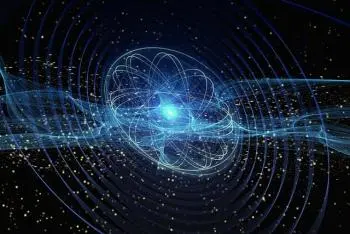
Quantum physics is a branch of physics that studies phenomena that occur at very small scales, such as atoms and subatomic particles. Unlike classical physics, which describes the behavior of macroscopic objects, quantum physics focuses on the microscopic world, where the laws of classical physics no longer apply.
Quantum physics is based on several fundamental principles that differ from classical intuition. Some of these principles include:
- Wave-particle duality.
- Heisenberg uncertainty principle.
- Overlap.
- Pauli exclusion principle.
- Quantum entanglement.
Wave-particle duality
Subatomic particles can exhibit both particle and wave behaviors. This means that, in certain experiments, particles can behave like point particles, with a defined position and momentum.
However, in other experiments, interference patterns that are characteristic of waves can be observed, such as the interference of two slits.
Double slit experiment
A famous example of this duality is the double slit experiment. When a beam of particles, such as electrons or photons, is fired through a two-slit barrier, an interference pattern is observed on the detection screen.
This pattern can only be explained if we consider that the particles behave like waves that interfere with each other. However, when observing closely, individual particles are detected at specific points on the screen, behaving like point particles.
Heisenberg uncertainty principle
The Heisenberg uncertainty principle, formulated by physicist Werner Heisenberg, establishes a fundamental limitation on the precision with which certain properties of a subatomic particle can be known.
The principle states that both the position and momentum (or momentum) of a particle cannot be known simultaneously with absolute precision. This implies that the more precisely the position of a particle is measured, the less precision we have about its momentum, and vice versa.
This limitation is related to the wave nature of subatomic particles. The more the description of a wave is "tightened" (i.e., its spatial extent is reduced), the more it expands in the space of moments, and vice versa.
This is expressed by the well-known Heisenberg inequality:
Δx * Δp >= h/4π
Where:
-
Δx represents the uncertainty in the position.
-
Δp is the uncertainty at the moment.
-
h is Planck's constant.
Overlap
One of the most intriguing concepts in quantum physics is superposition. According to this principle, quantum particles can exist in multiple states at the same time until a measurement is made.
This means that a particle can be in a superposition of different positions, momenta, energies or other properties.
Schrödinger's cat
A classic example of superposition is Schrödinger's cat experiment.
In this thought experiment, a cat is placed in a closed box along with a device that has a 50/50 chance of killing the cat. According to quantum mechanics, before opening the box and making the observation, the cat is in a superposition of being alive and dead at the same time.
Only when the box is opened and the observation is made does the cat's quantum state collapse into one of two possible outcomes: alive or dead.
Pauli exclusion principle
 The Pauli exclusion principle, formulated by Wolfgang Pauli, states that two identical fermions, like electrons, cannot simultaneously occupy the same quantum state in a given system.
The Pauli exclusion principle, formulated by Wolfgang Pauli, states that two identical fermions, like electrons, cannot simultaneously occupy the same quantum state in a given system.
This principle is essential to understand the distribution of electrons in atoms and molecules. It prevents two electrons from sharing all their quantum numbers, including spin, ensuring a unique and specific distribution of electrons across energy levels and sublevels.
This quantum constraint is fundamental to the stability of matter and has significant implications in the formation of the atomic structure and the periodic table of the elements.
Quantum entanglement
Quantum entanglement is a phenomenon in which two or more particles are intricately correlated with each other, such that the state of one particle is instantly related to the state of the other, even if they are separated by large distances.
This implies a non-local connection between the entangled particles.
Entangled particle experiment
A well-known experiment that illustrates quantum entanglement is the entangled particle or Bell pair experiment.
In this experiment, when two entangled particles are separated and measured for complementary properties, such as polarization, the measurement results are correlated in ways that cannot be explained by classical theory.
This means that the quantum state of one particle is instantly linked to the quantum state of the other, regardless of the distance between them.
This phenomenon has been confirmed experimentally and is used in technologies such as quantum cryptography to guarantee communications security.
Difference between quantum physics and quantum mechanics
Quantum physics and quantum mechanics are terms that are often used interchangeably and refer to the same field of study. However, it is possible to make a subtle distinction between the two terms.
Quantum physics is a broader term that encompasses all aspects of quantum theory, including not only quantum mechanics but also other related fields such as quantum field theory, quantum electrodynamics, quantum information theory, and quantum physics. statistical quantum theory, among others.
In this sense, quantum physics encompasses a variety of theories and principles that explain the behavior of particles and systems at very small scales.
Quantum mechanics, on the other hand, refers specifically to the branch of quantum physics that deals with the description and understanding of the behavior of subatomic particles and physical systems at the quantum level.
It is the most fundamental and widely known quantum theory, and establishes the principles and equations that govern the behavior of particles at the microscopic level.